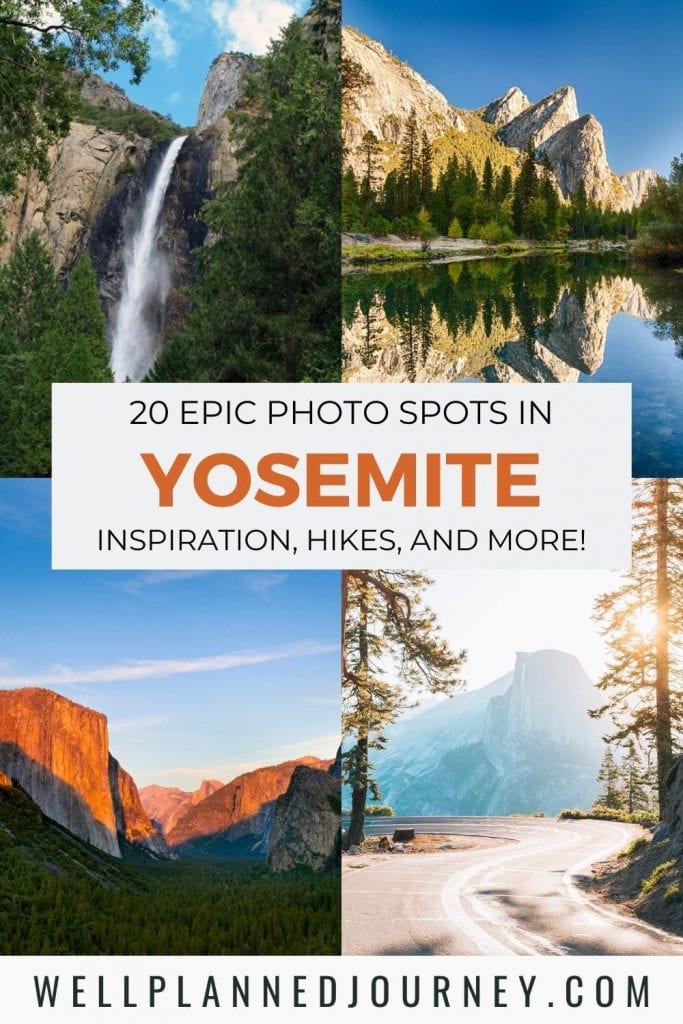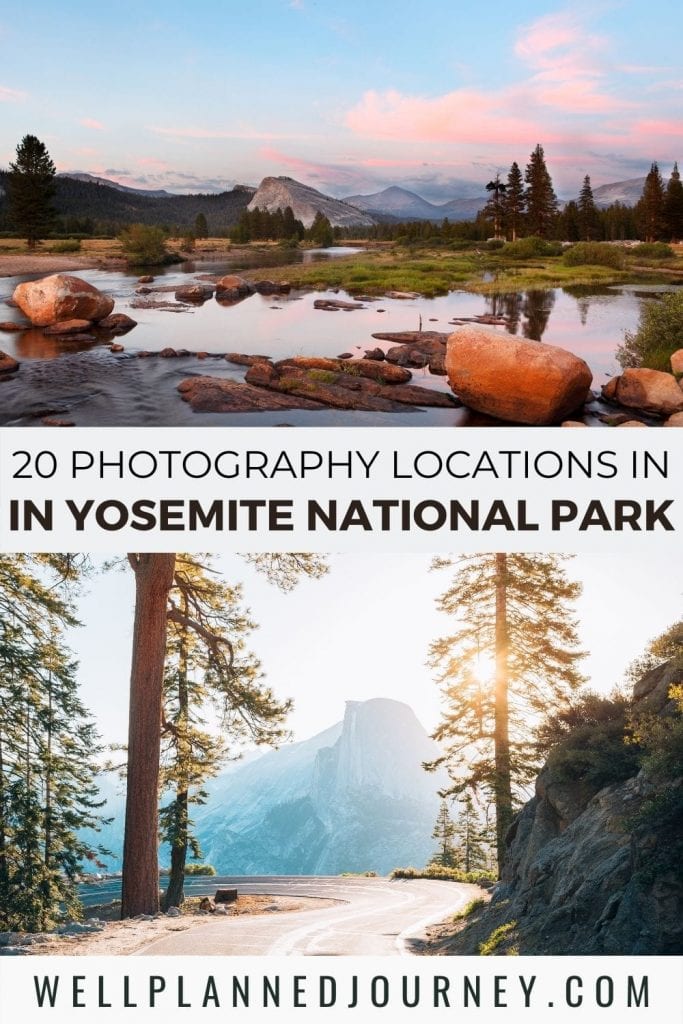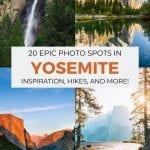Yosemite National Park is one of the most scenic places in the United States. From the towering Yosemite Valley walls to the redwoods in Mariposa Grove, there’s something beautiful to see at every turn.
This post takes you to 20 jaw-dropping Yosemite photography spots, with hikes and drive-up viewpoints. You’ll be able to capture mountains, waterfalls, meadows, and redwoods.
Plus I’m sharing essential tips to help you plan your trip to Yosemite National Park, including:
- Getting to and around Yosemite
- Best time of year to visit for photography
- Where to stay both inside and outside the park
- What to pack for an epic photographer’s getaway
Are you ready to photograph the most scenic national park in the United States? If so, let’s get started.
This post may contain affiliate links, where I may receive a small commission at no additional cost to you. Read more in this disclosure policy.
Yosemite National Park At-A-Glance
Before diving in, here are a few highlights to help you plan your trip:
- Best Time to Visit: Mid-Spring to Mid-Fall Late Fall is the best time to go to Yosemite. In the Spring, waterfalls are abundant. In the Fall, you’ll find plenty of Fall colors. The Summer months are the busiest time of year – be sure to book your trip in advance!
- Where to Stay: If you’re looking to stay in the park, I recommend choosing between The Ahwahnee or Yosemite Valley Lodge. Outside the park, book a spot at the nearby Rush Creek Lodge or the Tenaya Lodge at Yosemite.
- How to Get There: The closest airport is in Fresno, California, about 2 hours away. You can also fly into San Francisco or Oakland, both 4 hours away. Use Expedia to browse flights and find the best price.
- How to Get Around: The easiest way to get around Yosemite is in your own car. Use Expedia to browse deals on rental cars or rent an RV or campervan with Outdoorsy.
- Best Self-Guided Tour: My favorite way to learn more about the park is with Guide Along, a narrated self-guided tour perfect for road trips and scenic drives. The Yosemite Guide provides incredible commentary and detail about the history and geology of Yosemite.
- Don’t Forget: Be sure to get an America the Beautiful National Park Pass ahead of time. This $80 pass is valid for 12 months and get you into all 400+ national park sites (including Yosemite!).
Getting to Yosemite National Park
Yosemite National Park is tucked away in the eastern part of California in the Sierra Mountain range. The closest major city, Sacramento, is over 3 hours away.
To get to Yosemite, you’ll either need to road trip or fly into one of the “nearby” airports.
The closest airports to Yosemite National Park are:
- Fresno (FAT) – 2.5 hours
- Sacramento (SMF) – 3.5 hour drive
- Oakland (OAK) – 3.5 hour drive
- San Francisco (SFO) – 4 hour drive
- San Jose (SJC) – 4 hours
I use Expedia to find the best flight prices and compare routes. Once you find your flight, you can book directly through Expedia to save money, but still enter your frequent flyer numbers to get points!
If you need a rental car, I also recommend using Expedia to find the best deals across brands like Avis, Hertz, Enterprise, Budget, and more.
Getting to These Yosemite Photo Spots
You have two options for getting around Yosemite: the park shuttle or driving your own vehicle.
Driving Your Own Car Around Yosemite
Generally, I recommend driving your own vehicle as it gives you more flexibility and allows you to explore the park at your own pace.
This is vital if you plan on exploring before sunrise or after sunset when the shuttles aren’t running.
But parking can be difficult, particularly in Yosemite Valley from June to September.
To avoid hassles with parking, I recommend spending most of your time in the park at the beginning or end of the day.
You’ll beat peak crowds in the middle of the day and get the best light for photographing the park’s landscapes!
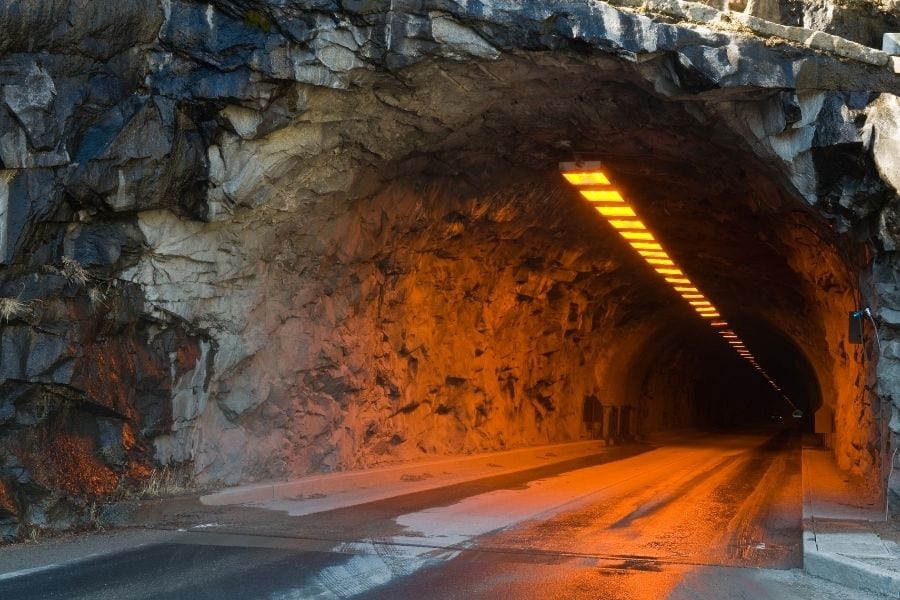
Taking the Yosemite National Park Shuttle
Yosemite National Park offers several free shuttles. One loop through Yosemite Valley and others take you to Mariposa Grove, Tuolumne Meadows, and Glacier Point.
If you’re staying in the park, particularly in Yosemite Valley, these shuttles can help you get around without needing to move your vehicle.
Unlike other parks, the shuttle is not required and is more of a convenience for those who don’t wish to battle for parking.
The Best Time of Year for Photographing Yosemite
You’ll get all four seasons in Yosemite National Park, from scorching hot summer days to snowy winter mornings. Each season in Yosemite offers different views, things to do, and photos to capture.
Summer (June to August)
Summer is the most popular season in Yosemite. With kids out of school and all roads in the park open, nearly 700,000 visitors flock to the park each month.
At the peak of summer, it’s common for temperatures to reach 90 degrees. Rain is rare. Bugs, particularly mosquitos, are out in full force. After mid-summer, most waterfalls in the park are starting to dry up.
But, summer is one of the best times to explore parts of the park that are closed other times of the year, like Tuolumne Meadows and Tioga Pass Road.
The roads to some of the park’s most famous scenic drives, Tioga Pass Road and Glacier Point Road, usually don’t open until late May or early June.
You can find historic road opening dates here.
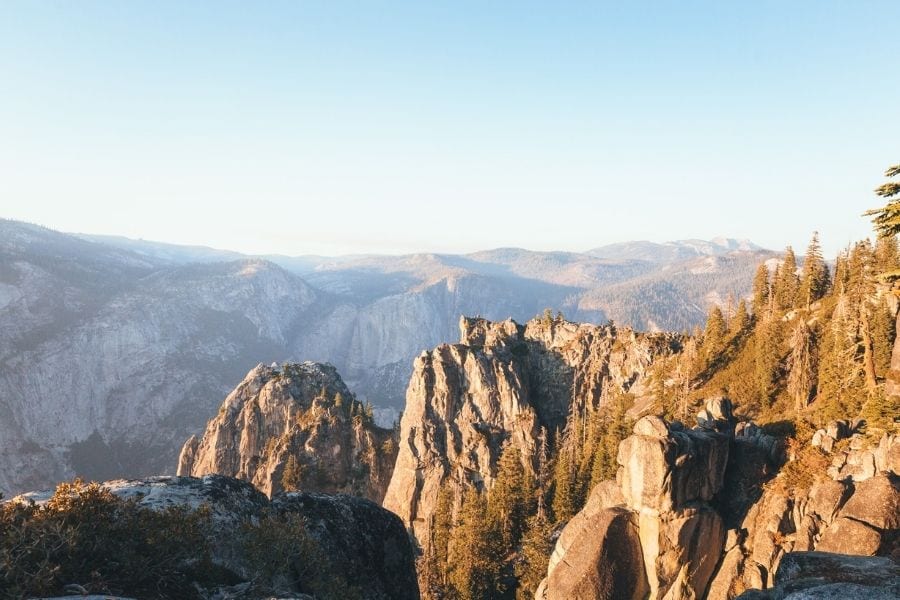
Fall (September to November)
Temperatures begin to drop in late September and crowds decline with it. While September days still average in the 80s, by late November temperatures peak around 55 degrees.
Fall is my absolute favorite time to visit Yosemite. The leaves turn shades of yellow and orange (although nothing compared to the aspens you’ll find on the other side of the Sierras in Mammoth).
The once bright green meadows throughout Yosemite Valley turn brown, almost like hay. I think this makes the park that much more beautiful.
This is the best time of year to photograph Half Dome, El Capitan, and the views along Glacier Point Road.
The con of visiting Yosemite in the fall, particularly for photographers, is that all the waterfalls and many of the lakes are dried up. Don’t expect to see the signature view of Yosemite Falls or Mirror Lake this time of year.
Tioga Pass Road and Glacier Point Road usually close in early to mid-November before the first heavy snowfall. Click here to see historical road closure dates.
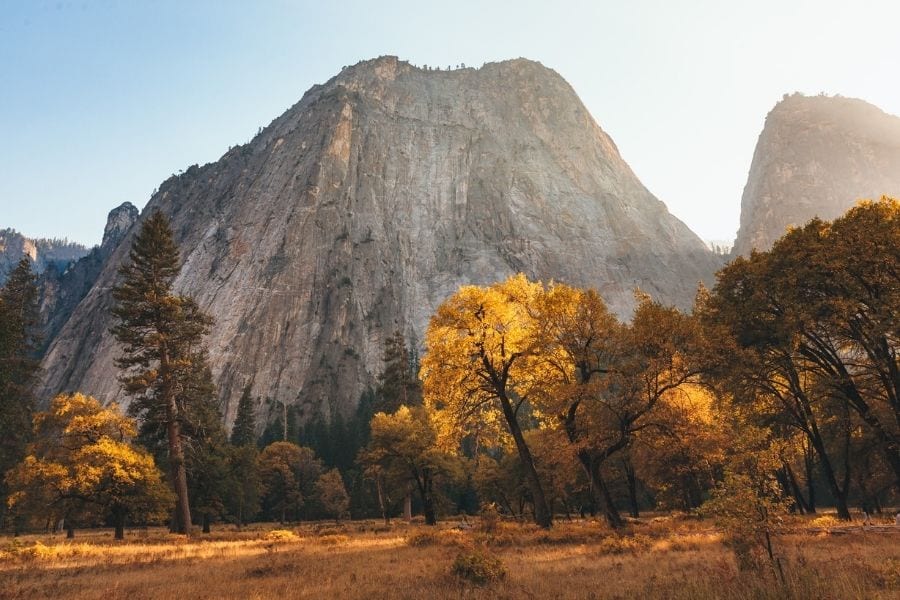
Winter (December to February)
Winter in Yosemite is a stark contrast to the busy days of summer. Many of the park’s roads are closed, snowfall is common, and nightly temperatures are consistently below freezing.
But that means fewer visitors and fewer crowds! An average winter day in Yosemite gets only 4,000 visitors compared to roughly 23,000 in the summer.
This is the best time of year to photograph snowy landscapes in Yosemite Valley.
It’s also the time of year when you’ll find Yosemite’s most unique natural phenomenon: the Firefall! The Yosemite Firefall is a unique occurrence where Horsetail Falls glows a bright orange at sunset.
It requires perfect conditions: enough snowmelt, a cloudless sunset, and the exact time of year where the angle of the sun is just right. This usually happens the second week of February each year.
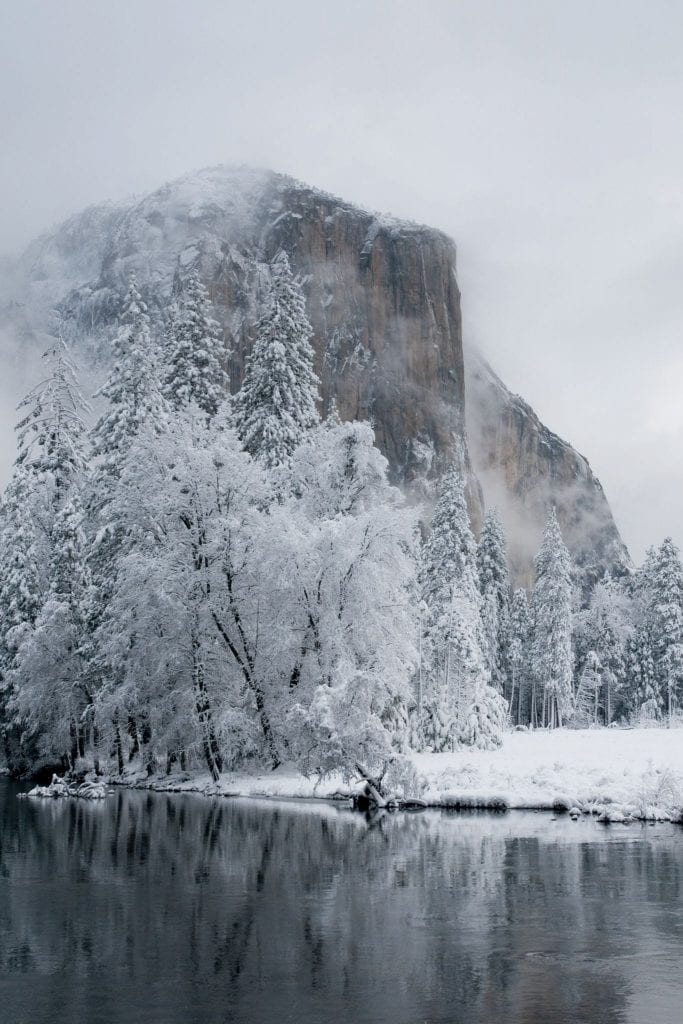
Spring (March to May)
As the snow melts, Yosemite’s many waterfalls begin to flow again. In early Spring, many roads are still closed until snow melts completely. By May, temperatures are warm, waterfalls are full force, and the park’s greenery is alive.
In April, flowers begin to bloom and Dogwood trees come alive. This is the best time of year to photograph the park’s waterfalls and lakes, like Yosemite Falls, Bridalveil Falls, and Mirror Lake.
The roads to Glacier Point and Tioga Pass both open from May to June, depending on how much snow accumulated in the winter.

Where to Stay In and Around Yosemite National Park
As a large and popular park, Yosemite has plenty of places to stay in park. Visitors can choose between lodges, campgrounds, and glamping sites in the park.
There are even some Airbnb rentals inside the park! Outside of the park, you’ll find plenty of hotels, RV parks, and campgrounds.
Where you stay will depend on what you want to do. Generally, staying in Yosemite Valley is the most central way to access the entire park. This is where I recommend first-time visitors stay.
If you’re visiting Yosemite again and want to spend more time off the beaten path, stay in Tuolumne Meadows or Mariposa Grove instead.
No matter where you choose to stay, plan to book well in advance, even in off-seasons:
- Lodge reservations are released 366 days out and tend to book up quickly. For best selection, plan to book roughly a year out. In the off season, you may be able to find reservations a few months in advance.
- Campground reservations are released a month at a time, 5-months out. If you want to book a campsite in Yosemite between May 15 and June 14, be prepared to book that site when reservations open on January 15 at 7am PST. All reservations are made via Recreation.Gov.
- Airbnbs in the park and other nearby accommodations tend to book up at least 3 months out. For best selection, start looking for a place to stay 3 to 6 months out.
This interactive map can help you search all the available hotels and rental properties near Yosemite National Park! Simply scroll and click the map below to see what is available!
Yosemite Valley
Yosemite Valley is the most popular area in the park thanks to its central location, beautiful landscapes, and amenities.
Here you’ll find plenty of places to stay, plus a full grocery store, post office, and visitor center.
Here are the best places to stay in Yosemite Valley:
- The Ahwahnee – a luxury, more expensive hotel with fine dining and amenities
- Yosemite Valley Lodge – a more affordable option close to many activities in Yosemite Valley
- Curry Village Glamping – a campground with permanent canvas tents and small cabins
- Housekeeping Camp Glamping – a campground with canvas tents, including electricity and a patio
- Upper Pines, Lower Pines, and North Pines Campgrounds – a cluster of campgrounds for tent and RV campers with more than 350 sites
- Camp 4 – a shared campsite popular among rock climbers available one day in advance via a lottery
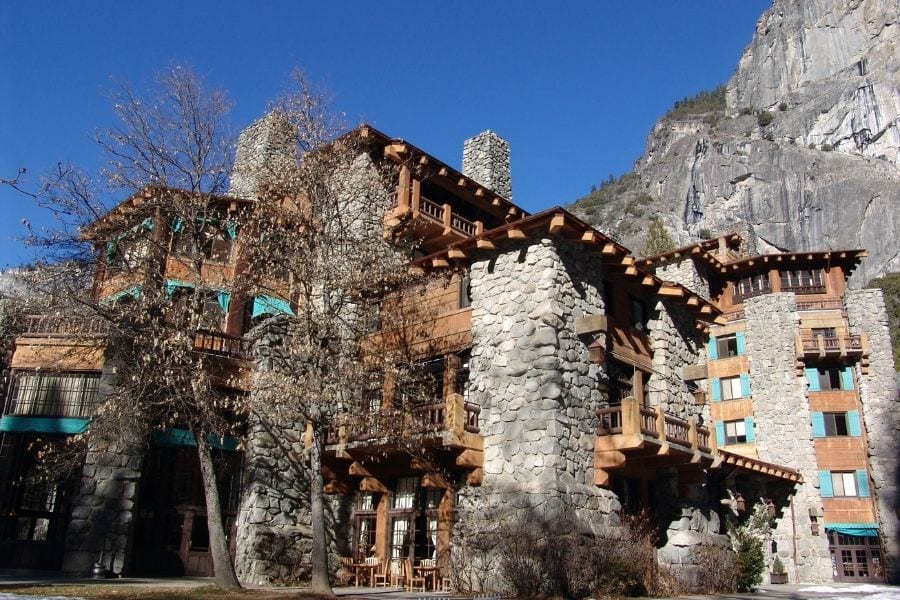
Tuolumne Meadows
- Tuolumne Meadows Lodge – a glamping site with canvas tent cabins including a wood burning stove
- Tuolumne Meadows Campground – a campground off Tioga Pass Road, typically only open from June to September
Wawona
- Wawona Hotel – a Victorian-style hotel with a swimming pool, golf course, and dining room
- Wawona Campground – a campground near Mariposa Grove, typically only open from June to October
Airbnbs Inside the Park
Yosemite West is an area located inside park boundaries with private homes. There are over 100 homes in this area available to rent on Airbnb, ranging from studios to bigger homes.
In fact, I’ve written an entire blog post on the best Airbnbs in Yosemite National Park.
Plenty of Airbnb reservations are available in Wawona too, located off Wawona Road near Mariposa Grove.
Staying in an Airbnb is the perfect option for families or groups who want to stay together and save money by cooking their own meals.
Be sure to book at least 3 to 6 months in advance for the best selection!
Read More: 25 Best Airbnbs in Yosemite National Park
Outside the park
While I recommend staying in the park if you can, there are also options outside of the park. By staying outside the park, you’ll add about 1 hour of driving each way to get to Yosemite Valley.
Typically reservations are available outside the park on shorter notice. For the best selection, aim to book at least 3 to 6 months out.
Here are some of the best places to stay outside of Yosemite:
- Yosemite Pines Cabins and Campground – a campground with tent and RV sites and cabins in Groveland, about 1 hour 15 minutes from Yosemite Valley
- Rush Creek Lodge – a cozy, higher-end lodge just outside the Big Oak Flat entrance, about 1 hour from Yosemite Valley
- Tenaya Lodge at Yosemite – an award-winning, higher-end lodge in Fish Camp, south of Wawona, about 1 hour 20 minutes from Yosemite Valley
- Yosemite Southgate Hotel – a nice budget hotel in Oakhurst, about 1.5 hours from Yosemite Valley
- Best Western Plus Yosemite Gateway Inn – a nice chain hotel in Oakhurst, about 1.5 hours from Yosemite Valley
- Dimond O Campground – a nearby campground in Stanislaus National Forest, about 1 hours from Yosemite Valley
Don’t miss the best things to do in Yosemite on your upcoming trip! This free, printable self-guided walking tour of Yosemite Valley covers all the best points of interest, plus a free map and exclusive tips!
Download your free self-guided Yosemite tour here.
Map of Yosemite Photography Spots
If you’re a visual learner like me, this map will be super helpful! You can check out each of the photography spots this guide covers in detail to get a better idea of where they are.
See the Yosemite Photography Spots map here.
Best Photo Spots in Yosemite National Park
Now that you know where to stay, when to visit, and how to get to Yosemite National Park, it’s time to dive into the 20 best Yosemite photography spots!
Tunnel View
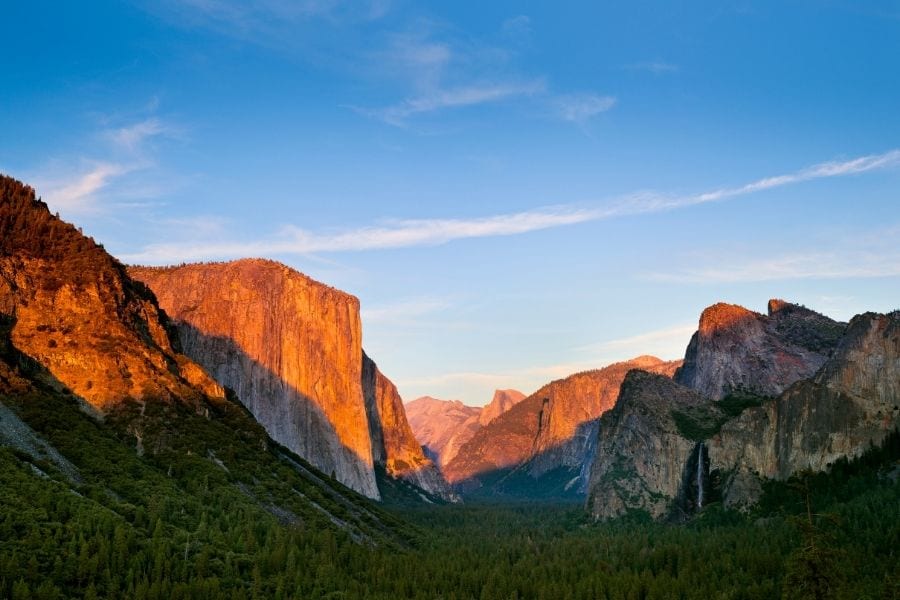
- Location: Yosemite Valley, just before the Wawona Tunnel
- Type: Drive Up Viewpoint
- Best Time of Day: Sunrise or Sunset
- Best Season: All year
Tunnel View is the most popular viewpoint in Yosemite National Park. From here, you have an iconic view of El Capitan, Half Dome, Bridalveil Falls, and the entire valley.
The Tunnel View vantage point is only steps away from the parking lot, just before the Wawona Tunnel.
Tunnel View is best seen at sunset, where shadows from the valley walls are minimal and El Capitan and Half Dome shine in great light.
Visiting at sunrise means fewer crowds, limited shadows, and the potential to capture fog rolling into the valley.
Since Tunnel View is so popular, parking can be difficult, even with a large parking lot. Be sure to arrive at least 30 minutes before the time you’d like to start shooting to get a good spot.
Bridalveil Falls
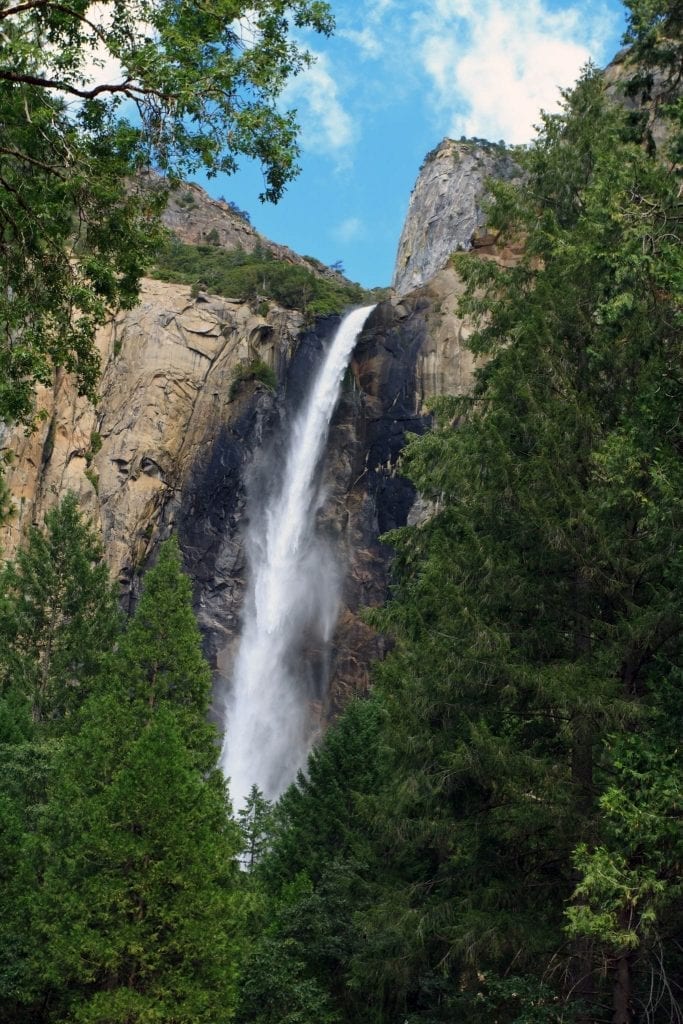
- Location: Yosemite Valley
- Type: Hike (easy 0.5 miles roundtrip)
- Best Time of Day: Late afternoon before sunset
- Best Season: Spring
Bridalveil Falls is one of the most popular waterfalls in Yosemite. It’s visible from plenty of spots, like Tunnel View. Unlike other waterfalls in the park, Bridalveil Falls has at least some water flowing all year.
But Spring is the most impressive time of year to spot this waterfall.
For an up-close view of the falls, head out on a short hike along the Bridalveil Falls trail. The viewpoint at the end provides a good view, but it isn’t the best view. Instead, consider shooting Bridalveil Falls from the parking lot to capture its scale.
The waterfall is cast in shadow in the morning. By the late afternoon, the waterfall will be illuminated and out of the shadows.
El Capitan
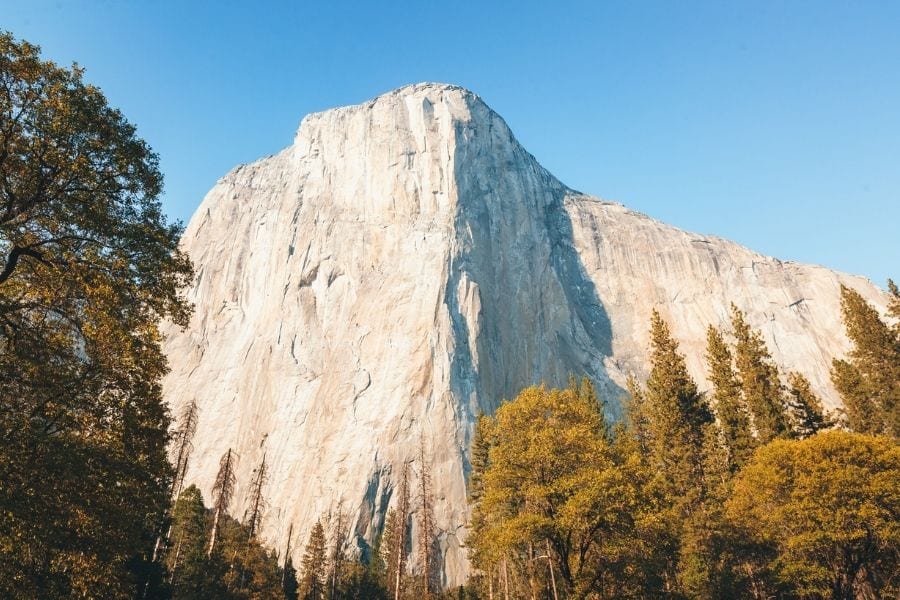
- Location: Yosemite Valley
- Type: Drive Up Viewpoint
- Best Time of Day: Afternoon or evening
- Best Season: All year
El Capitan is considered one of the best rock climbing destinations in the world. Many people recognize El Capitan from the documentary Free Solo. Each year, climbers flock to “El Cap” to conquer the dangerous climb.
The best spot to view this iconic, sheer granite rock face is from El Capitan Meadow. The meadow is directly across from El Capitan is lush green in the Spring and Summer and a golden brown in Fall and Winter.
If you have a telephoto lens, you’ll even be able to capture the rock climbers!
Parking spots line the road along El Capitan Meadow. You’ll usually be able to find a spot here, even at midday. El Capitan can also be seen from Tunnel View, best captured here at sunrise or sunset.
Yosemite Falls
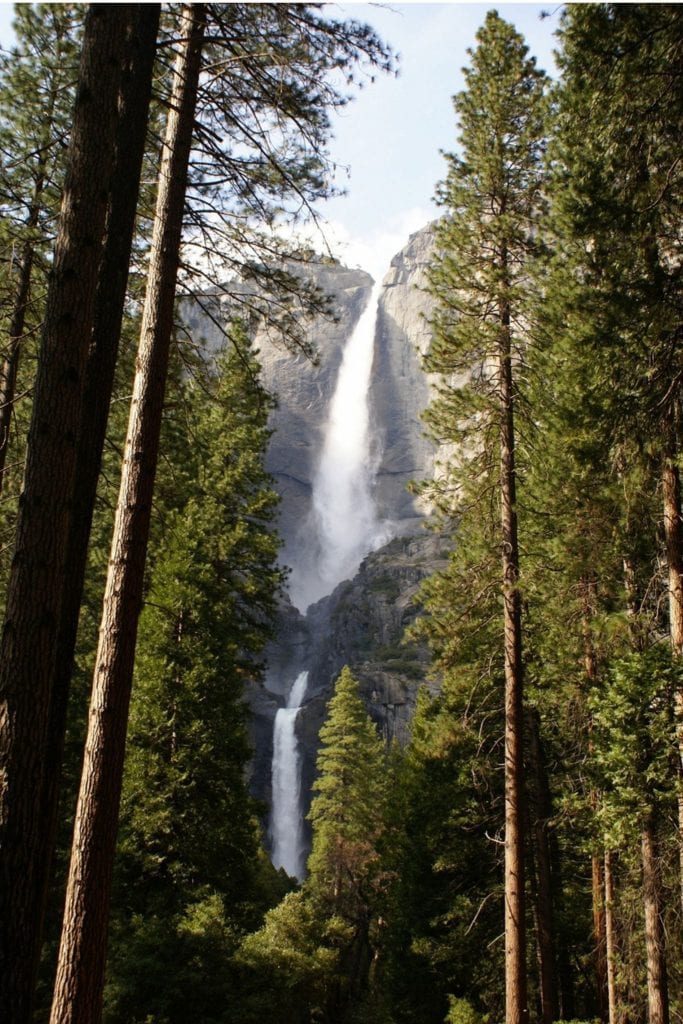
- Location: Yosemite Valley
- Type: Hike (easy 1 mile loop)
- Best Time of Day: Morning
- Best Season: Spring
Yosemite Falls is the tallest waterfall in North America at 2,425 feet. The falls cascade down through Upper Yosemite Falls and then Lower Yosemite Falls.
From Spring to early Summer, the falls crash down in full force, fueled by snowmelt.
It can be seen throughout Yosemite Valley from viewpoints near Yosemite Village and Yosemite Valley Lodge. Most visitors choose to view Yosemite Falls from the Lower Yosemite Falls Viewpoint.
Those looking for a hike can take the strenuous 7-mile trail up to the top of Yosemite Falls instead.
One of the best views is from the walkway leading to the falls. Trees line the path, perfectly framing Yosemite Falls in the middle. This vantage point allows you to capture the waterfall in its entirety.
If you visit Yosemite Falls in the early morning, you may even be able to catch a rainbow!
Half Dome from the Meadow Along Northside Drive
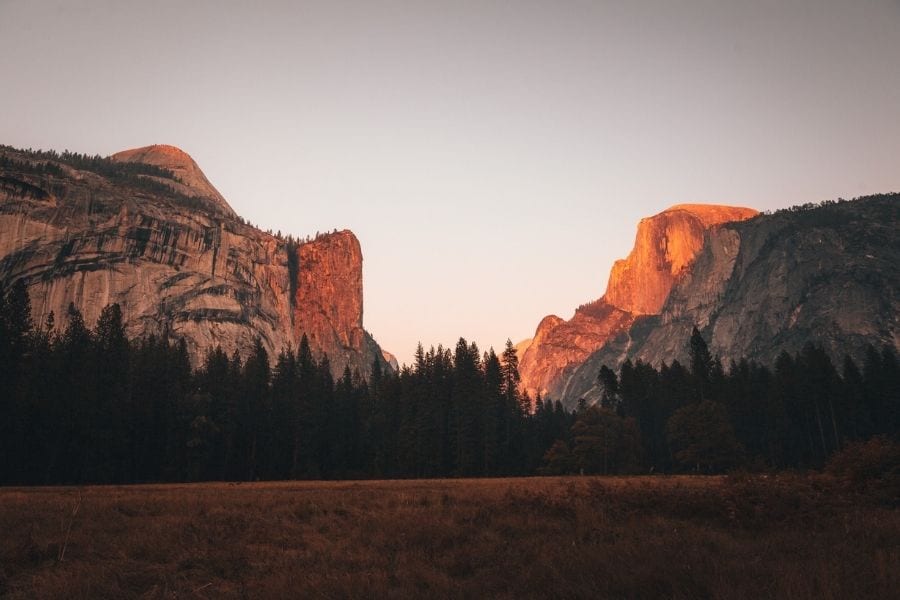
- Location: Yosemite Valley
- Type: Drive Up Viewpoint
- Best Time of Day: Just before sunset
- Best Season: All year
Half Dome is one of the most iconic views in Yosemite National Park. Some hikers choose to make the quest to the top each year on a strenuous hike. But Yosemite Valley is best captured from further away.
It can be seen from many spots throughout the park, but one of the best unobstructed views is from the meadow along Northside Drive. This meadow is right between the Village Store and The Ahwahnee Hotel.
Just before sunset, the light captures Half Dome, illuminating it a fiery golden red. The effect only lasts for a few minutes but is worth every minute. Parking shouldn’t be an issue in the evenings along Northside Drive.
You should be able to find a spot to pull over and capture the iconic sunset view of Half Dome.
Read More: The Ultimate Day Trip to Yosemite National Park
Merced River
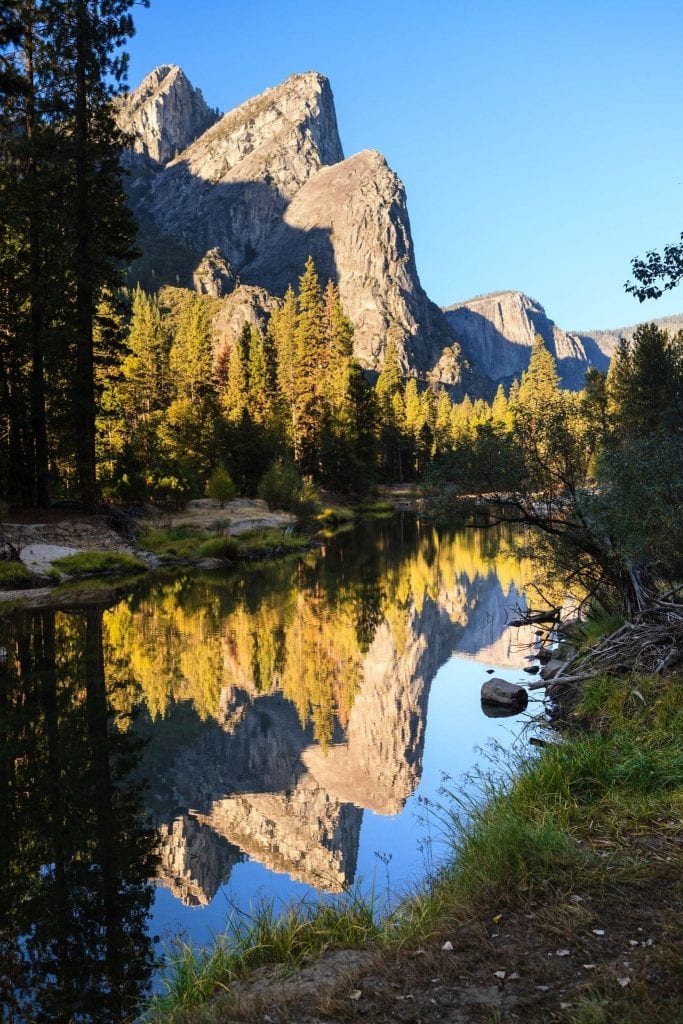
- Location: Yosemite Valley
- Type: Drive Up Viewpoint
- Best Time of Day: All day
- Best Season: Spring
The Merced River flows through the High Sierras, down through Yosemite Valley, and out of the park for nearly 150 miles. Since the river runs through the entire valley, there are plenty of spots to capture it.
One of the best views is along the riverbank near Cathedral Beach.
From here you can capture both El Capitan and the Three Brothers. One of my favorite views is of the Three Brothers reflected in the Merced River.
You can park at the small lot near the Cathedral Beach Picnic Area and walk along the river to this spot.
Nevada and Vernal Falls

- Location: Yosemite Valley
- Type: Hike (strenuous 5.4 miles roundtrip)
- Best Time of Day: Afternoon
- Best Season: Spring to early Summer
Vernal and Nevada Falls is one of the best waterfall hikes in Yosemite. While challenging, at the end, you’re rewarded with not one, but two epic views of waterfalls.
You’ll start at the Happy Isles Trailhead before climbing up nearly 3 miles on the Mist Trail up to the top of Nevada Falls. From the trailhead, the climb to Nevada Falls is about 2,000 feet, so this trail is not an easy one.
Vernal Falls is about halfway through the hike, only a little over 1 mile and 1,000 feet from the trailhead. For a more moderate hike, turn around after Vernal Falls instead.
This is one of the most popular trails in the park, particularly in the Spring and early Summer when the waterfalls are at full flow. The best time to photograph these falls is in the afternoon or an overcast day.
Since the trail takes you right along the falls, you and your camera will likely get wet. Be sure to bring something to wipe your lens off! But thanks to the mist, you might be able to catch a rainbow.
Don’t miss the best things to do in Yosemite on your upcoming trip! This free, printable self-guided walking tour of Yosemite Valley covers all the best points of interest, plus a free map and exclusive tips!
Download your free self-guided Yosemite tour here.
Yosemite Falls from Swinging Bridge
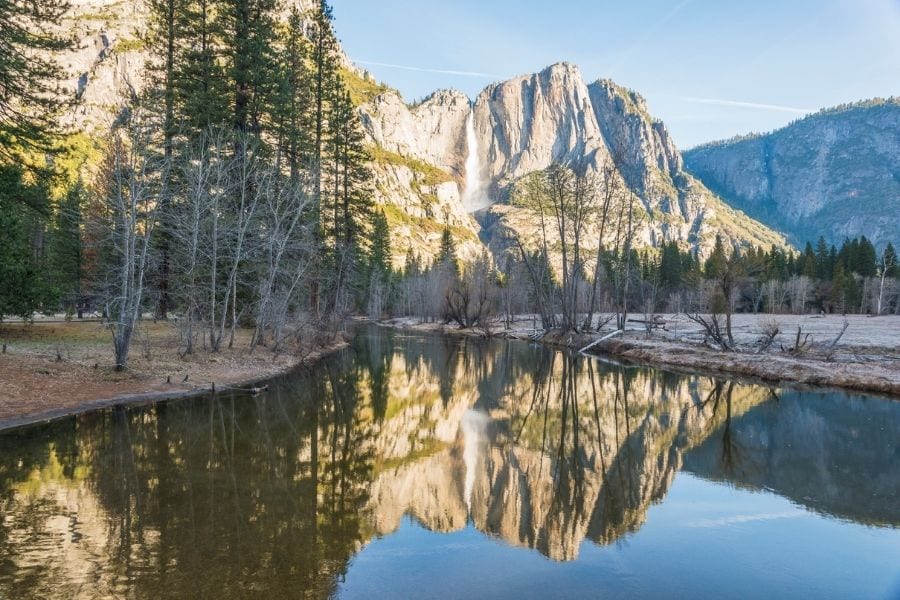
- Location: Yosemite Valley
- Type: Short Walk
- Best Time of Day: Sunrise or Sunset
- Best Season: Spring to early Summer
As the tallest waterfall in North America, Yosemite Falls can be seen throughout the valley. One of the best views of Yosemite Falls from a distance is from the Swinging Bridge crossing the Merced River.
As you might guess, this bridge across the Merced River used to swing. Today the bridge is fixed in place for visitors’ safety.
You’ll find this spot along Southside Drive, between Yosemite Chapel and the Sentinel Beach Picnic Area. There’s a small parking lot here, so it will be tough to find a spot at midday.
Instead, photograph this spot at sunrise or sunset. Bring a telephoto lens to get a closer shot of Yosemite Falls.
Mirror Lake

- Location: Yosemite Valley
- Type: Hike (easy 2 miles roundtrip).
- Best Time of Day: Early morning
- Best Season: Spring to Summer
In the Spring, the snow melts across Yosemite and flows down from the High Sierras in waterfalls. That water collects in beautiful, full lakes like Mirror Lake. This view is a must in spring and summer.
The short hike to Mirror Lake is flat, only 1 mile out to the lake. If you want to extend the hike, you can take the full loop around the entire lake.
From the edges of the lake, Yosemite’s rock walls and trees are reflected in the water. To catch Mirror Lake in dreamy lighting, head to this spot just after sunrise. You won’t want to miss the views of Half Dome from here!
In the fall, the lake completely dries up. While not as photogenic this time of year, it’s still a peaceful hike.
Sentinel Bridge
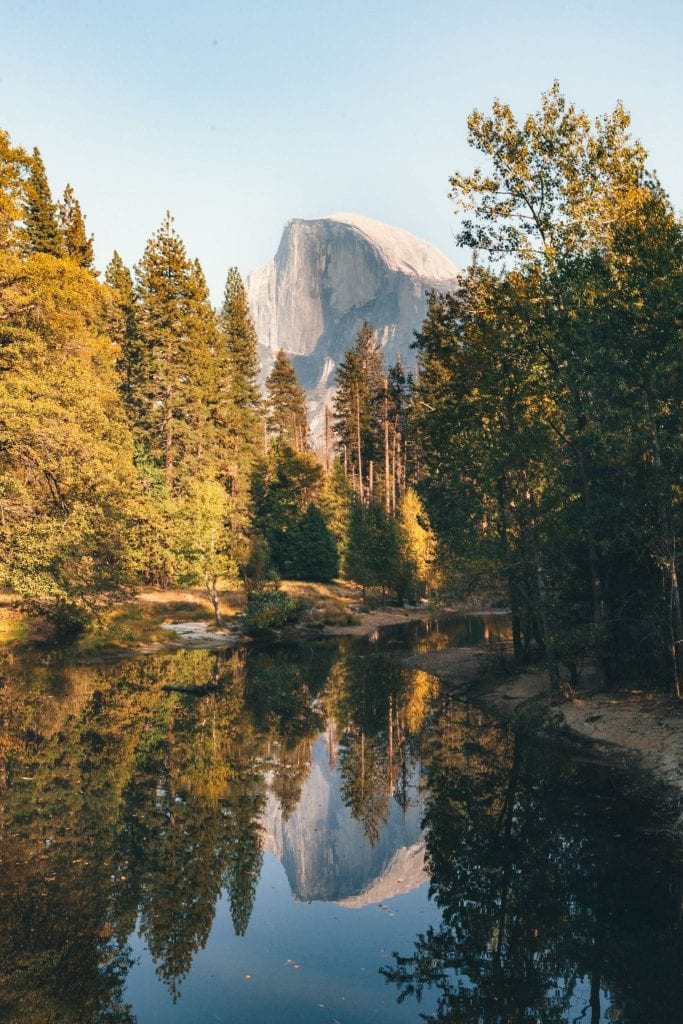
- Location: Yosemite Valley
- Type: Drive Up Viewpoint
- Best Time of Day: Sunrise or Sunset
- Best Season: All year
My absolute favorite view of Half Dome is from Sentinel Bridge (and that’s saying something given there’s so many). This bridge crosses the Merced River. Here the river is calm, perfectly reflecting Half Dome.
In the fall, the leaves surrounding the river pop with yellows, oranges, and light greens. This is definitely a popular spot among photographers. Often tripods are lined up along the bridge.
The best time to capture this spot is at sunrise or sunset. The magnificent pinks, purples, and oranges are reflected in the Merced River, making for a beautiful photo.
I recommend parking at one of the many lots around Yosemite Valley and strolling through the meadows to get here.
Half Dome from Glacier Point Road

- Location: Glacier Point Road
- Type: Short Walk
- Best Time of Day: Sunrise
- Best Season: Late spring to early fall
Yet another view of Half Dome! This vantage point is along Glacier Point Road. Just before reaching the end of the road at Glacier Point, the trees open as the road turns back on itself.
Glacier Point Road bends in a tight U-shape directly in front of Half Dome. This spot is incredibly popular among Instagrammers.
There isn’t parking or even a shoulder to pull off at this point. To get here, you’ll need to park at the lot from Glacier Point and walk back up to the viewpoint. The walk from Glacier Point is about 5 to 10 minutes.
The best time to capture this view is at sunrise when the light is soft and golden. You’ll be able to set up your tripod just off the road without worry of traffic. That early in the morning the road is pretty empty.
Valley View

- Location: Yosemite Valley
- Type: Drive Up Viewpoint
- Best Time of Day: Sunset
- Best Season: All year
There’s plenty of stunning viewpoints in Yosemite Valley. But this one provides peaceful views of both El Capitan and the Merced River.
You’ll find this spot along Northside Drive, past El Capitan. The small parking lot at Valley View has about 10 spots. This lot gets crowded in peak season, particularly in the middle of the day.
To avoid crowds, come in the morning or the evening instead.
The lighting on El Capitan is great around sunset. This can also be a scenic spot in the winter when the meadows and trees are covered in snow.
Cook’s Meadow
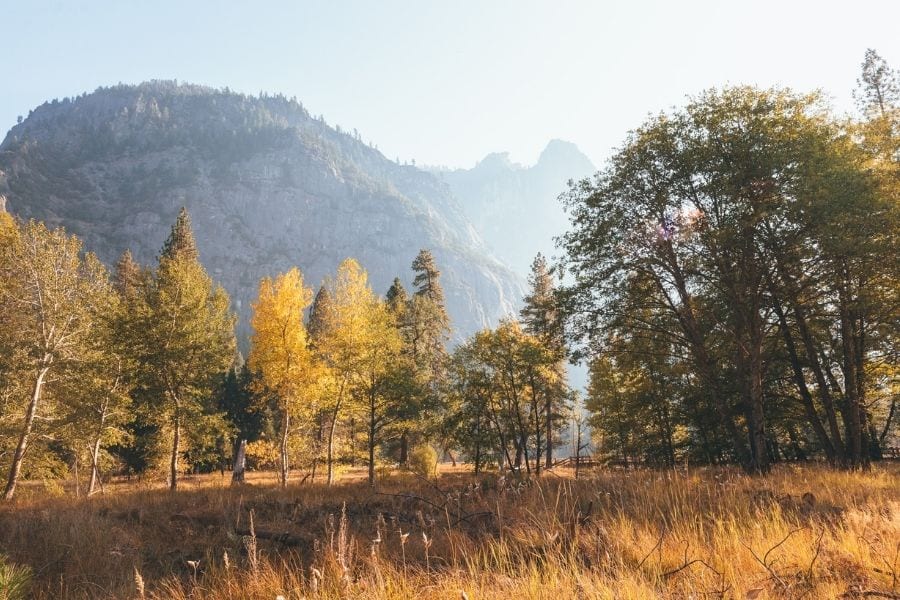
- Location: Yosemite Valley
- Type: Short Walk
- Best Time of Day: Late afternoon
- Best Season: Spring to Fall
Yosemite Valley is filled with expansive grassy meadows. In the spring and summer, they are lush and green. By the fall, these meadows turn a beautiful shade of golden brown.
Cook’s Meadow is located between Yosemite Falls and Sentinel Bridge. From here, you can see stunning views of both Yosemite Falls and Half Dome. You may even be able to spot wildlife grazing in the meadow!
My favorite photographs of Cook’s Meadow are taken along the wooden boardwalks, elevating you above the grass. It makes for the most dreamy golden hour shots, particularly in the fall when the grasses are muted.
In the spring, the green grass and boardwalks make for the perfect foreground with Yosemite Falls in the background.
Glacier Point
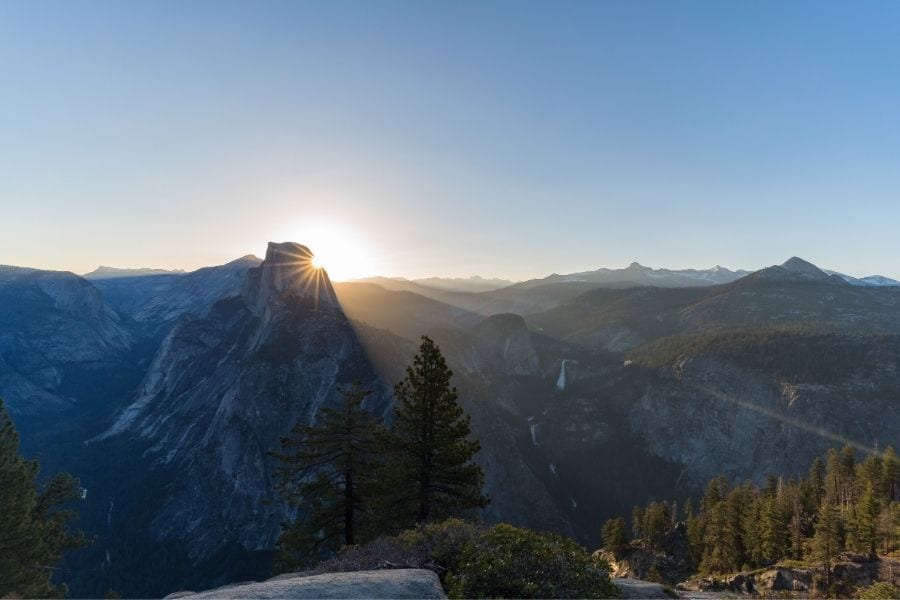
- Location: Glacier Point Road
- Type: Hike (easy 0.5 miles roundtrip)
- Best Time of Day: Sunrise
- Best Season: Late Spring to Mid Fall
Glacier Point Road takes you high above Yosemite Valley to the final viewpoint: Glacier Point. From here you can overlook Yosemite Valley, Half Dome, and the High Sierras.
The road is only open from May to early November, depending on snowfall, so this spot is best visited from late Spring to early Fall.
While it’s most popular to drive to this point, Glacier Point can also be reached on a hike. The Four Mile Trail takes you from Yosemite Valley up to Glacier Point. This strenuous trail is 9.6 miles round trip and gains 3,200 feet.
For photographers, I recommend taking the driving alternative. The scenic drive along Glacier Point Road is well worth the drive!
The views at Glacier Point are best at sunrise. This is also the easiest time to find parking here. The soft light illuminates the valley and highlights the beautiful granite peaks.
This is one of the best spots outside of the valley to view Half Dome. You can also spot Vernal and Nevada Falls from here.
Taft Point
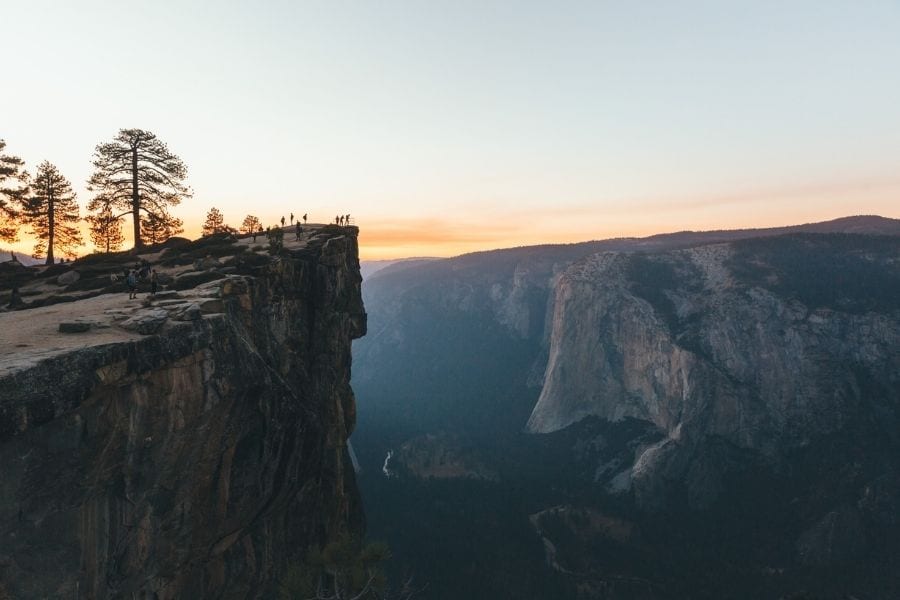
- Location: Glacier Point Road
- Type: Hike (easy 2.3 miles roundtrip)
- Best Time of Day: Sunset
- Best Season: Late Spring to Mid Fall
Taft Point is hands down one of the best spots in Yosemite for sunset. The easy hike to Taft Point starts along Glacier Point Road at the Sentinel Dome trailhead. You’ll follow the 1-mile trail each way to a stunning cliff drop-off.
The observation point extends out over Yosemite Valley, over a 2,000-foot drop to the valley floor. From here you can see the Merced River running along the valley floor and fantastic views of El Capitan.
This vantage point definitely isn’t for those with a fear of heights, but you can still get a great photo keeping your distance from the ledge.
At sunset, the sky turns bright orange then purple, highlighting all the granite rock faces through the valley. Due to the impressive nature of this spot, expect plenty of crowds and plan to arrive at least 45 minutes before sunset.
Don’t forget a headlamp for hiking back in the dark after sunset!
Sentinel Dome
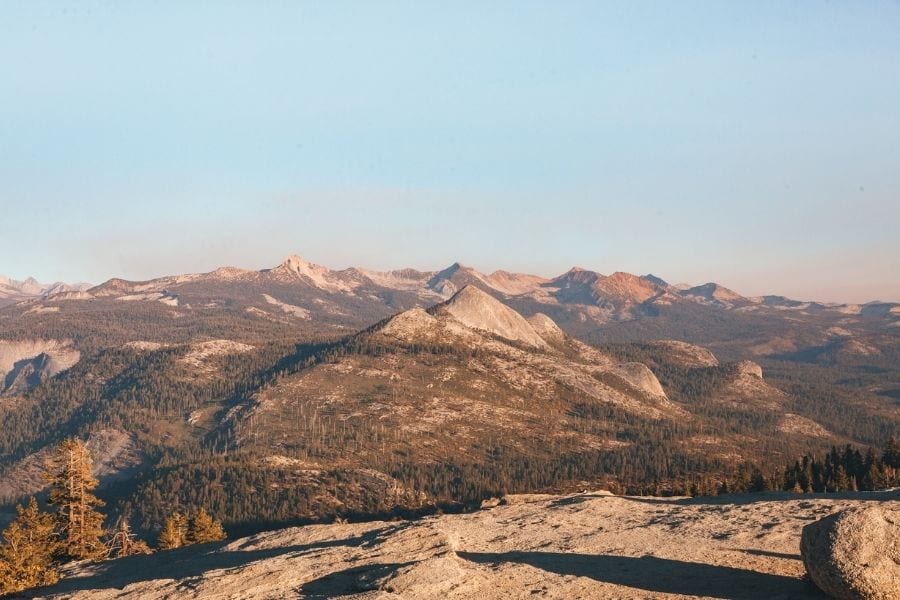
- Location: Glacier Point Road
- Type: Hike (easy 2.1 miles roundtrip)
- Best Time of Day: Sunset
- Best Season: Late Spring to Mid Fall
Sentinel Dome is one of the best views in Yosemite National Park. From the top of the dome, you can see full 360-degree views of Half Dome, El Capitan, and Yosemite Falls.
The trail to Sentinel Dome starts at the same point as the trail to Taft Point. The small parking lot along Glacier Point Road fills quickly, but you’re allowed to park along the side of the road here.
You’ll hike 1 easy mile along the trail until you reach the base of Sentinel Dome. The hardest part is a steep, but short incline up the side of the rock. It’s difficult but manageable.
The best time to photograph Yosemite from Sentinel Dome is at sunset or a golden hour just before. The golden glow paints Yosemite Valley in dreamy light.
Most hikers choose to combine Sentinel Dome into a loop with Taft Point for a 2.2-mile round trip hike.
I recommend starting a few hours before sunset, stopping at Sentinel Dome first for Golden Hour, and heading to Taft Point before sunset.
Tuolumne Meadows
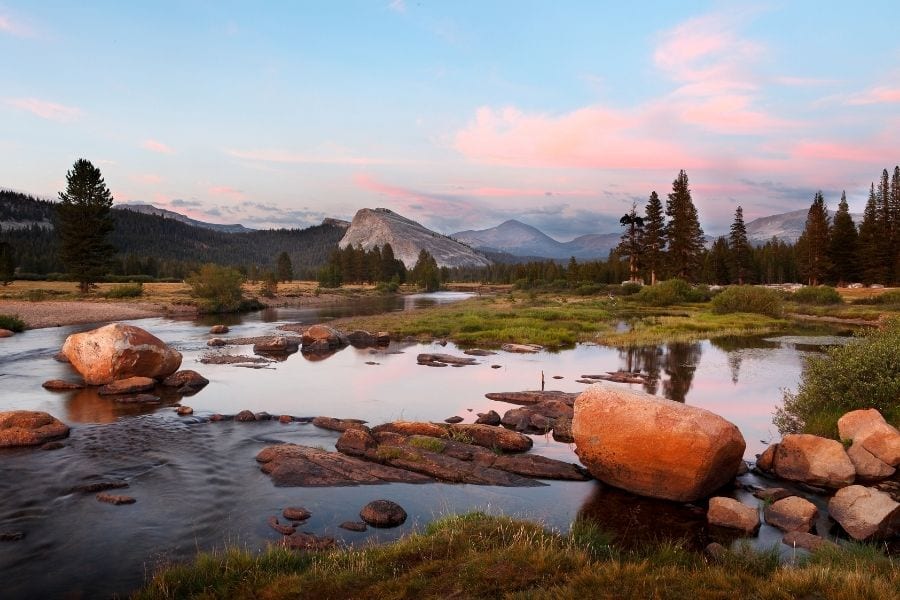
- Location: Tioga Pass Road
- Type: Drive Up Viewpoint
- Best Time of Day: Golden hour after sunrise or before sunset
- Best Season: Late Spring to Mid Fall
Tuolumne Meadows is another underrated spot outside of Yosemite Valley. You’ll find this meadow along Tioga Pass Road, north of the valley. Tuolumne is filled with grassy fields and clear alpine lakes.
The calm, quiet fields in Tuolumne Meadows are a stark contrast to the hustle and bustle of Yosemite Valley.
As one of the largest high-elevation meadows in the Sierra Nevada, Tuolumne offers incredible views in all directions. From here, you’re 8,600 feet above sea level!
There isn’t one specific viewpoint to capture the meadows. Simply find your favorite spot in the area off of Tioga Pass Road and explore.
Golden hour at either sunrise or sunset is a great time to capture the peaceful beauty of Tuolumne Meadow.
Olmsted Point

- Location: Tioga Pass Road
- Type: Drive Up Viewpoint
- Best Time of Day: Sunset
- Best Season: Late spring to mid Fall
Olmsted Point is one of the best drive-up viewpoints in the park. From this vantage point, you can see the expansive High Sierras perfectly framing Half Dome.
While there’s plenty of spots to capture Half Dome around the park, this one provides a unique vantage point away from the crowds.
At sunset, the sky comes alive with color, highlighting the view of Half Dome, Clouds Rest, and Tenaya Lake.
Tioga Pass Road is only accessible from late Spring to mid Fall due to snowfall, so be sure to visit this spot in the peak season.
Cloud’s Rest
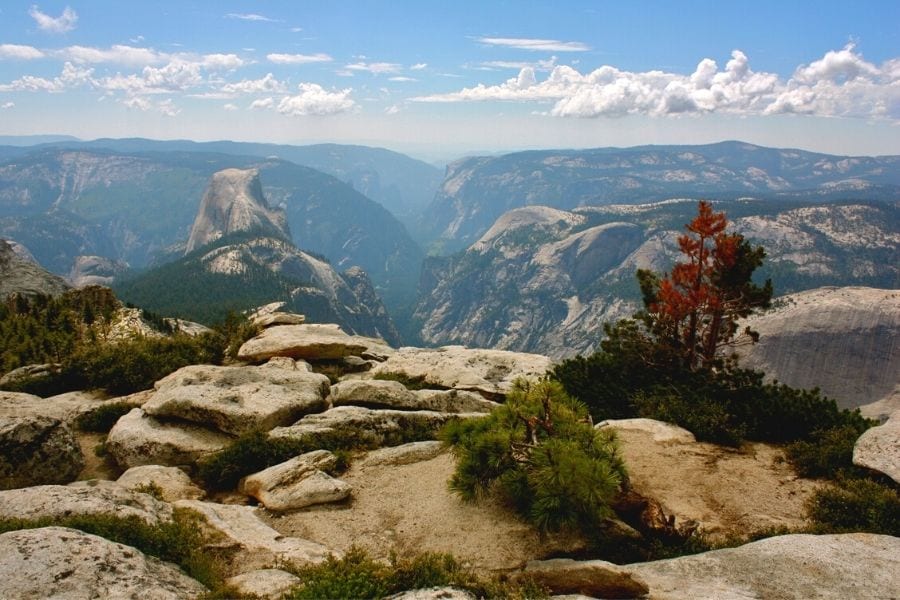
- Location: High Sierras
- Type: Hike (strenuous 14.5 miles roundtrip)
- Best Time of Day: Early morning
- Best Season: Late spring to early fall
Cloud’s Rest is one of the most challenging hikes in the park. The trail to the Cloud’s Rest viewpoint covers 14.5 miles roundtrip and climbs 1,775 feet. This hike is definitely not for the out-of-shape or unprepared.
This hike will take all day and is incredibly difficult. But the long hike rewards you with one of the best views in Yosemite.
From the final viewpoint, you can see 360-degrees. Some of the most notable landmarks visible from here are Half Dome, Sentinel Dome, El Capitan, and Tenaya Lake.
This spot is most photogenic at sunrise, but that would require hiking over 7 miles in the dark. Instead, I recommend starting just before dawn to arrive at the top early in the morning.
The best trailhead for this hike is off of Tioga Pass Road, so this trail is only accessible from late spring to early fall.
Mariposa Grove
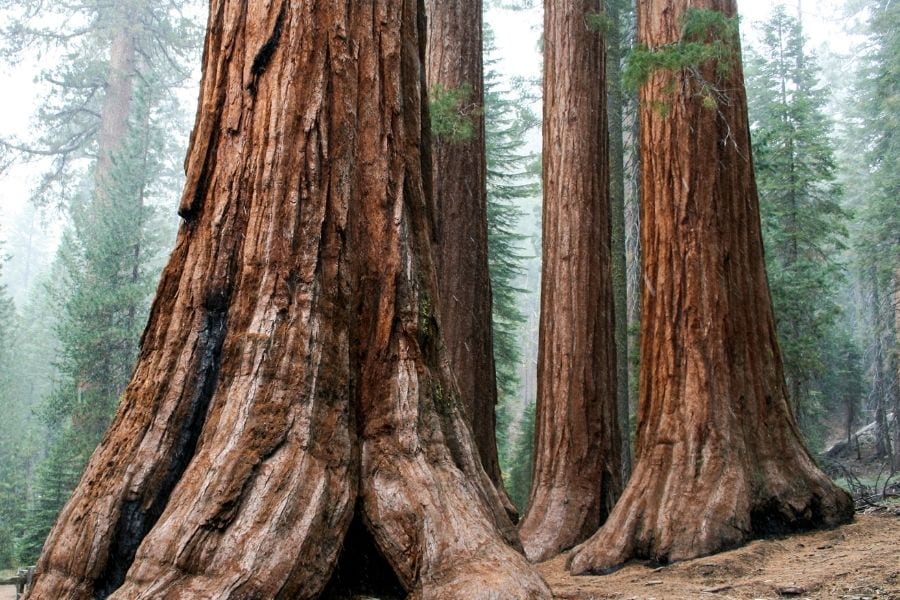
- Location: Wawona
- Type: Hike (easy 0.3 mile loop)
- Best Time of Day: Early Morning
- Best Season: Spring to Fall
When people think of Yosemite they generally think of stunning granite mountains. But Yosemite National Park is home to some giant redwood sequoia trees too!
At the southern Wawona entrance to the park, you’ll find a grove of giant sequoias in Mariposa Grove. There are over 500 giant trees here, some as old as 2,400 years.
The best way to explore the grove is on the Big Trees Trail, a short quarter-mile loop.
With limited parking, Mariposa Grove gets very crowded later in the day. For the best lighting and avoiding crowds, visit early in the morning shortly after sunrise.
Mariposa Grove is also open in the winter for those that want to snowshoe amongst the giant sequoias.
Tips for Yosemite Landscape Photography
Yosemite is incredibly scenic with so much to capture. Here are a few tips to help you get the most of your trip to Yosemite and prioritize which spots to photograph:
- Prioritize your trip. It’s impossible to fit all these spots into one trip. If you’re short on time, don’t miss Yosemite Falls (in the spring or early summer), Sentinel Bridge, Cook’s Meadow, Tunnel View, and Taft Point.
- Start your day early. Crowds in Yosemite are no joke. Start at sunrise to beat the crowds at the best photography spots. Glacier Point and Yosemite Falls are both excellent choices for sunrise.
- Arrive early for sunset photos. Parking is competitive in the park, particularly in Yosemite Valley. You may have to circle a parking lot to find a spot or park further away and walk. I recommend arriving at least 30 minutes early to ensure you find parking. Taft Point, Sentinel Dome, and Tunnel View are some of the best spots to capture sunset in Yosemite.
- Download Google Maps offline to ensure you can navigate without service. To do this, go to your Google Maps app, select your profile next to the search bar, and choose ‘offline maps’. From there click ‘select your own map’ and drag the view to your custom area.
Are you visiting multiple national parks in the next year? The America the Beautiful National Park Pass gets you into 400+ national park sites, including all 63 national parks, for 12 months!
Get your national park pass ahead of time for only $80.
What to Pack for Your Trip to Yosemite
- Camera – If you’re looking to capture any of these Yosemite photography spots, you’ll need a camera. While you’ll capture the best photos with a DSLR camera, even an iPhone or GoPro (they shoot in 5K now!) will do. I highly recommend investing in a sturdy camera clip to secure your camera to your hiking backpack. The Peak Design Capture Clip is the best one out there.
- Layers – In the Spring and Fall, weather can vary dramatically between day and night. While the mornings may start off cool, afternoons can be hot. Pack moisture-wicking shirts and fleece layers to keep you comfortable for those sunrise and sunset shoots.
- Headlamp – To get the best late, you’ll start your day early and end late. Be prepared by packing a headlamp with fresh batteries.
- Hiking Backpack and the 10 Essentials – It’s important to carry safety gear every time you hike. Be sure to pack the 10 hiking essentials and bring a hiking backpack with plenty of room for water and extra gear.
- Bug spray – Bug Spray is a must for Summer in Yosemite National Park. If you’re planning any hikes near lakes or rivers, be sure to apply bug spray underneath your hiking layers before starting your day.
Looking for more tips on what to pack for your trip? Check out my guides on the best hiking gear, what to pack for a road trip, and essential camping gear for all my favorite gear picks and tips to make packing for your trip a breeze!
Frequently Asked Questions About Photography in Yosemite
Can you take pictures in Yosemite?
You can take pictures anywhere in Yosemite National Park. The best time of day to photograph Yosemite National Park is in the early morning or late afternoon around Golden Hour.
Where can I take a picture of Half Dome?
The two best spots to take a picture of Half Dome are from Washburn Point along Glacier Point Road around sunrise and from Cook Meadow around sunset.
Final Thoughts on the Best Yosemite Photography Spots
Yosemite National Park has beauty at every turn – and you’ll want to capture it all! If you’re short on time in Yosemite, don’t miss these epic photo spots:
- Tunnel View
- Taft Point
- Glacier Point
- Sentinel Bridge
- Yosemite Falls
- Cook’s Meadow
- El Capitan Meadow
Looking for more things to do on your trip to Yosemite? Check out these posts:
Don’t miss the best things to do in Yosemite on your upcoming trip! This free, printable self-guided walking tour of Yosemite Valley covers all the best points of interest, plus a free map and exclusive tips!
Download your free self-guided Yosemite tour here.
Don’t Forget to Save This Post on Pinterest
